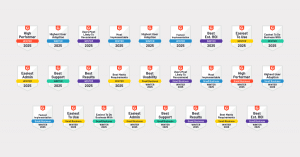Co-CEO of Australian tech darling Atlassian, Scott Farquhar, said the company was changing tack entirely with their management systems. Their new methodology will enable them to measure the “outcomes, not clock hours” of their, now entirely dispersed, staff. “Let’s face it,” he said, “2020 has been a year of huge change for all of us. How we work has changed forever and we must pioneer this change.”
Agreed, Mister Farquhar. In fact, we here at Total Synergy couldn’t agree more. And so, we present you with the view from our August Synergy update — you won’t need binoculars to take this beauty in.
Resource balancing — where we were on our path to planning perfection
You’ll recall from several of our last releases, we’ve been on this journey from long-term, broad-view planning down through a more and more granular series of focus points, to where we are now with the August release. This is where we get to look at what specific items people are actually working on. If you remember rightly, it’s been a very scenic planning path to this point, and it’s only getting prettier in its detail.
In one recent release, we talked extensively about the new feature where you can enter exactly the number of hours you want somebody to work on something in the next week. That’s a way of delegating — it enables you to define the project to be worked on, who’s going to do the work, and when they’ve got to do it by. That isn’t very specific, but it’s delegation, nonetheless.
Now, the above is definitely useful. It’s a sanity check to make sure there’s enough people on the team to make it at least plausible that they’ll finish the work on time. It also checks that everybody in the company has been put on a team where they’re contributing and will be busy (we don’t want people sitting around doing nothing, especially if others are working overtime). That’s called resource balancing.
But how do you then measure somebody’s performance in that week? Excellent question!
I said I want you to work eight hours per day for a week on project X. At the end of the week, I say, ‘Did you work eight hours a day on that project?’ And you say, ‘Oh yes. Yes, I did!’ Then I go ahead and marvel at what a fantastic employee you are — you did such an awesome job because you spent eight hours a day on that project. Just like I asked you to.
But, hold on a second … I’m sure I’m missing something here. There’s another measure I need isn’t there? Why yes, there is.
Measuring performance — where we are now on our path to planning perfection
What is it that’s missing? If the goal I set was for you to sit in an office chair for a certain number of hours, then, the only way I can measure your performance against that goal is to check that you sat in the chair for the requisite number of hours.
Okay. That worked when you were in the office, because I could see that your rear was firmly in the chair. Therefore, I knew you were doing a good job. You were sat very appropriately. With a straight back. I’ve never seen anybody sit so appropriately. Well done.
But now you’re not in the office. What am I going to do? This is a problem managers are facing — it’s the first thing that happened when people started working from home. They started saying, ‘Oh geez, how am I going to make sure that person X is sitting correctly in her chair for eight hours? I can’t be there and see, so what am I going to do? Maybe I need to put a video camera in her bedroom? No, that doesn’t sound right. But I’ve got to work something out to make sure she’s doing the right number of hours.’
Or, we could measure her usefulness to the company in a different way. Let’s think about that. And now we come back to that quote from the Atlassian co-CEO — we come back to measuring outcomes not hours.
Ta-da! To-dos! — Synergy’s August release to manage outcomes not hours
So how do you do that? You do it with to-dos.
The first part of to-dos is to say, ‘we’ve agreed that person X is going to work on this project for eight hours a day for the next week’. Sweet. But what are they actually going to do in those eight hours? Remembering the old truism, if you can’t measure it, you can’t manage it. And I can’t really morally measure how long they’ve sat in that chair when they’re at home.
I can’t use the old way. I’ve got to move now to managing person X, in a measurable manner. So, I’m going to make a list of the jobs that person is going to do within those eight hours a day for a week. Then I’m going to measure that I get those things done by the end of the week.
So, in the Synergy planning board, down with the tasks, you can build a to-do list that goes with that task. Then you can assign those to-dos to the staff member who’s to do them. Ta-da! Very nice vista there!
Additionally, your to-do list can be part of a template. Which means that when you select a project template, you can build up a standard to-do list that specifies when you do this kind of job, these are the things that somebody’s going to have to do — you don’t even need to rewrite that to-do list every time — it’s already there. Delete the ones you don’t need and allocate the ones that are left.
First-rate flexibility means freedom
Now, so long as a manager can see things being ticked off and getting done every day, they can feel confident that they’re heading comfortably towards their deadline. Stunning!
If person X ticked all their to-dos off in the first day, and then disappeared for the rest of the week, do I really care? Well, maybe I’ll give them more work next week, because clearly, they’re much faster than anybody else. But still, good for them.
If you got finished early, spend Friday doing nothing but researching trade magazines and doing little pet projects and whatever you like — because I got the work done that I felt was good value. And you got some time. On the other hand, tit for tat, if it looks like you’re not going to finish the work on time, sometimes you might have to work late, because it’s going to take you longer than you thought.
This style of management has a few benefits:
- You’re now measuring the outcome, not the time spent — which is to say, you’ve moved to a system that can be measured, and thus, managed — you can now measure person X’s success
- You’re giving your staff truly flexible working options — you don’t need to care if person X works 18 hours a day for a couple of days, and then take the rest of the week off, or if person X works in the mornings and takes afternoons off, or if person X has got kids they’re homeschooling during the day that they need to work around — you’re giving staff the freedom and independence to work to a schedule that works for them, so long as they’re ticking off their to-dos
This is especially interesting in these COVID times. Now that we have a distributed workforce, the old way of managing people doesn’t work. Now you’ve got to be able to have a Teams discussion on Monday morning and a wrap up on Friday night. Management means being able to agree with person X that they’ll get Y done by the end of the week and letting them manage their time for themselves.
All of a sudden, a manager’s life is easier too. They don’t need to be creeping around looking over people’s shoulders, wondering how they’re going. They can see how they’re going because they’re ticking off to-dos as they go.
Look at that perfect project planning panorama! Lovely.


